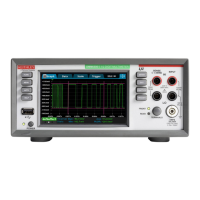Recommended test equipment
The following table summarizes the recommended calibration equipment. Specified accuracy of all
functions and ranges is dependent on the precision of reference signals used during the adjustment
process. To achieve specified performance, adjustment reference uncertainties must be at least four
times smaller than the best corresponding DMM6500 one-year accuracy specification for measuring
that signal.
Refer to the manufacturer's specifications to calculate the uncertainty, which varies for each function
and range test point.
General adjustment considerations
• DMM6500 DCV performance is sensitive to errors from thermoelectric potentials generated by
test cables and connections. Be sure to use high-quality cables and connection techniques.
When changing a connection during the adjustment process, be sure to allow time (up to five
minutes) for thermal settling. Also allow thermal settling time, typically 60 seconds, when
changing the Front/Rear switch position during adjustment.
• Calibration steps are performed on both rear and front inputs as described in sections below. Be
sure that the Front/Rear switch is in the proper position before sending adjustment commands.
• The Keithley Models 8610 and 8620 4-wire shorts connect all four terminals electrically, but the
layout of the board traces makes DMM6500 adjustment sensitive to their orientation. Note the
HI/LO terminal markings and be sure to insert connections in the correct orientation. Note that the
DMM6500 rear input terminals are rotated 90° compared to front-panel inputs.
• During adjustment steps using a calibrator reference source, be sure the calibrator reference
signal has fully settled before sending adjustment commands to the DMM6500.

